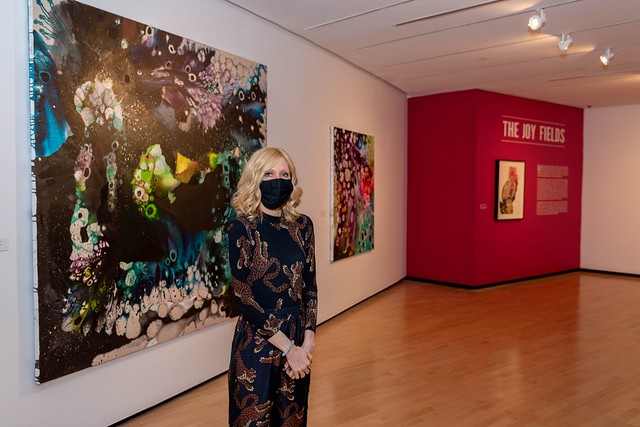Contrasting exhibitions at Jule Collins Smith Museum of Fine Art explore migration, loss, healing, environment
Article body
Three new exhibitions are on view at Jule Collins Smith Museum of Fine Art at Auburn University through Jan. 2: “Anila Quayyum Agha: The Weight of Black,” “The Joy Fields” and “Outside In.”
Related academic programs are being presented throughout the fall semester, and faculty from all disciplines also are invited to schedule classes or direct individual students for self-paced viewing.
“Our organizing theme for 2021 is juxtaposition,” said Cindi Malinick, museum director and chief curator. “From the Roman Baroque to contemporary craft, visitors have seen a wide range of artistic narratives and historical periods throughout the academic year. As we close, we focus on the fascinating work of two contemporary artists with unique storytelling styles along with a surprising way to interpret Auburn’s vast Audubon collection.”
“The Weight of Black” features three installations throughout the galleries: “Itinerant Shadows,” a series of small cubes set on the wall, “Shimmering Mirage,” a four-foot cube suspended in air, and “This is NOT a Refuge,” an illuminated eight-foot house. The black walls are covered in shadows, creating an immersive experience.
Agha, who will meet with students during the “Sculpture as Object” course during a campus visit, is a 2020-21 Smithsonian Artist Research Fellow at the Smithsonian American Art Museum.
“Having lived on the boundaries of different faiths such as Islam and Christianity, and in cultures like Pakistan and the United States of America, my art is deeply influenced by the simultaneous sense of alienation and transience that informs the migrant experience,” Agha said. “This consciousness of knowing what is markedly different about the human experience also bears the gift of knowing its core commonalities, and it is these tensions and contradictions that I try to embody in my artwork.”
“For a contrast in technique and media, the work of Auburn alumna Whitney Wood Bailey floods the galleries differently—with vibrant color and monumental scale,” said Malinick. “Her personal story is equally as compelling.”
With 24 paintings on view, “The Joy Fields” series began following a life-changing illness for the artist. Wood Bailey became intolerant to most foods, environments and even her painting process. The absence of a cure brought her to what she described as a dark place.
“After many months of practicing a particular neuroplasticity-based program, I was able to return to my studio and work with paint again, among other triumphs,” said Wood Bailey. “A new kind of joy, one that is not dependent on life circumstances, began to seep into my life, bringing energy, wildness and vibrancy into my work.”
The Georgia native, who is exhibited at home and abroad, said she considers the survey among her most personal, meaningful work, reflecting a journey toward healing. Museum visitors will have an opportunity to experiment with organic and controlled techniques during an artmaking activity inspired by the exhibition at 1:30 p.m. on Nov. 14.
Rounding out the exhibition schedule is the final installment of “Outside In,” a collaboration with the Museum of Natural History. Following examples of fruits, nuts and flowers, various insect specimens are paired with Audubon etchings.
“Scholars celebrate Audubon for the level of artistry in depicting birds and mammals, but there is even more environmental detail available in these prints,” said Malinick. “True-to-life size insects provide a complete picture of the habitat.”
The Audubon collection rotates and rests between viewings for conservation. Malinick said the approach for future exhibitions might likely involve collaborations to present this collection in other unexpected and interactive ways.
Located at 901 S. College St. in Auburn, the Jule Collins Smith Museum of Fine Art’s regular hours are Tuesday through Sunday, 10 a.m. to 4:30 p.m., with extended hours on Thursday from 10 a.m. until 8 p.m. Admission is free, and donations are welcome.
For more information, visit jcsm.auburn.edu.
Related Media
Media interested in this story can contact Communications Director Preston Sparks at (334) 844-9999 or preston.sparks@auburn.edu.
Auburn University is a nationally ranked land grant institution recognized for its commitment to world-class scholarship, interdisciplinary research with an elite, top-tier Carnegie R1 classification, life-changing outreach with Carnegie’s Community Engagement designation and an undergraduate education experience second to none. Auburn is home to more than 30,000 students, and its faculty and research partners collaborate to develop and deliver meaningful scholarship, science and technology-based advancements that meet pressing regional, national and global needs. Auburn’s commitment to active student engagement, professional success and public/private partnership drives a growing reputation for outreach and extension that delivers broad economic, health and societal impact.










